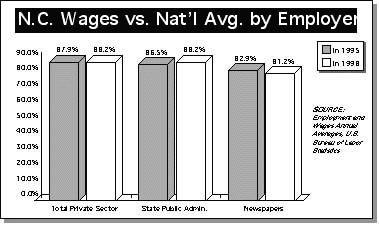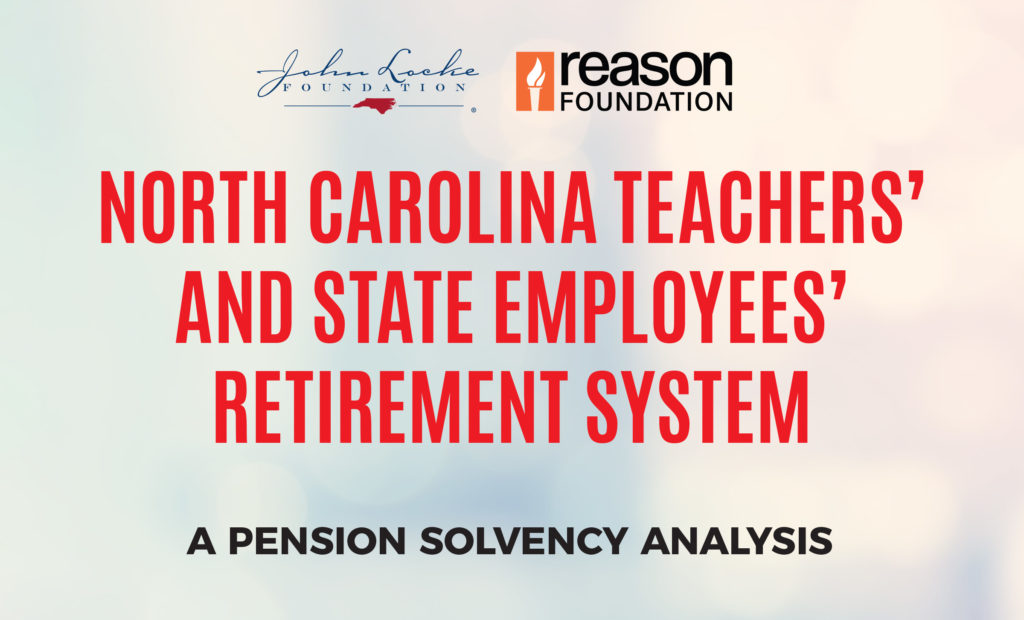When it comes to compensation issues, state employees are no different than other workers. They want higher wages, more benefits, better working conditions, and more job security. Leaders of the State Employees Association of North Carolina (SEANC) should be expected to lobby the General Assembly for more of each of these forms of compensation each year. On the other hand, elected officials are expected to watch out for taxpayers and ensure they receive high-quality government services at a reasonable cost.
The goal of both parties should be to satisfy their needs by achieving a mutually beneficial level of compensation. After all, taxpayers benefit from attracting and retaining an adequate and skilled state workforce. And state employees benefit when government is organized on sound and sustainable fiscal principles and imposes as little cost as possible in the form of taxes which they pay along with everyone else. The problem comes in choosing the appropriate indicators. Is state government adequately staffed with qualified employees? Is North Carolina atypical in its treatment of state workers? Are taxpayers getting their money’s worth?
It is more important than ever to answer these questions correctly as SEANC members call for pay raises of as much as 11.2 percent to redress what they see as inadequate compensation over the past few years. A key element of SEANC’s case is that vacancies in state government are high and growing. It is true that, as of June 2000, there were nearly 12,900 unfilled state positions (including the UNC system but not public school teachers). However, according to the State Personnel Office, only 1,182 of the positions are being advertised that is, the state is trying to fill them. This is an improvement. A year ago, the number of advertised vacancies was about 1,800.
Why the large discrepancy between total vacant positions and those that personnel managers are actively trying to fill? Every state department retains a number of excess positions on the books. These positions allow an agency to have flexibility in staffing to meet its goals (though sometimes agencies appear to have abused this flexibility, as recent revelations at the NCSU security department show). Even though recruiting for certain occupations or regions may well be difficult, there are generally numerous applicants for jobs that agencies want to fill.
Another argument made for dramatic across-the-board increases in state employee pay is that recent pay raises have not kept pace with raises in the private sector. But this fact doesn’t answer the right question. It doesn’t factor into the equat
ion the starting point of public and private salaries, changes in skills needed, and the value of job security. A better approach is to use a national standard to compare the relative compensation of public and private employees. In 1998 the 3 million-plus workers in North Carolina’s private sector earned 88 percent of the U.S. average for private sector workers. The 63,000 state government workers in public administration also earned 88 percent of the national average for their counterparts across the country (see graph). The figures in 1995 were 88 percent for private employees and 86 percent for public employees. In 1998 the total state government workforce of 145,000 employees earned 93 percent of the national average.
The relationships here are not surprising. In general, labor market conditions such as cost-of-living and vacancy rates can be expected to keep these two numbers fairly close together. When the two numbers are dissimilar, it might suggest that conditions in that state are more or less favorable to state employees vs. their private sector counterparts. A review of national data indicates that there is, indeed, a significant spread in some cases. For example, Arkansas, Iowa, and North Dakota appear to pay their state employees significantly more than one would expect a boost for the employees. On the other hand Georgia, Missouri, Texas, and Virginia have average public salaries much less than expected a bargain for taxpayers.
One private sector category in North Carolina that seems to be low is newspapers (Standard Industrial Classification Code 2711). In 1998 11,000 people in North Carolina worked for newspapers. These workers fell from almost 83 percent of the national average for their peer group in 1995 to 81 percent in 1998. While this may be perplexing to newspaper employees, it is merely a result of market forces unique to the industry and is hardly cause for government intervention.
While average pay is an important figure in understanding this complex issue, another important component would be the productivity of the workforce. In the private sector, one of the most common productivity measures of a for-profit organization is the firm’s return on investment. Productivity in the public sector is more difficult to assess. But if we assume that the quality of state services is roughly level across the country, then the ratio of state workers to private workers may be a good place to start. In 1998 the U.S. average of state workers in public administration was 1.7 workers for 100 private sector workers. In North Carolina it was 2.2 workers per 100 in the private sector. Using another data series from the Bureau of Labor Statistics reveals that there are 2.1 total state government workers for every 100 citizens in North Carolina, which again exceeds the national average of 1.6 workers. In both cases, North Carolina’s state workforce is larger in percentage terms than the national average and its state workers possibly less productive as a group when compared to other states.
Conclusion
None of these findings should be seen as conclusive proof of any proposition about state employee compensation in North Carolina. Legislative leaders should call upon their own research staff as well as the 80-person staff of the Labor Market Information Division at the Employment Security Commission to study this issue further. Taxpayers deserve an efficient workforce at a reasonable cost. When state employees can demonstrate they are more efficient than their counterparts across the country, their annual campaign for higher wages could take on greater significance. Also, government leaders should devise a quicker response to shortages of state workers in certain occupations or in some geographic locations as circumstances require. While SEANC has an obligation to promote its members’ interests, legislators have a matching responsibility to act as proper stewards of taxpayer money.
Don Carrington, Vice President for Research





